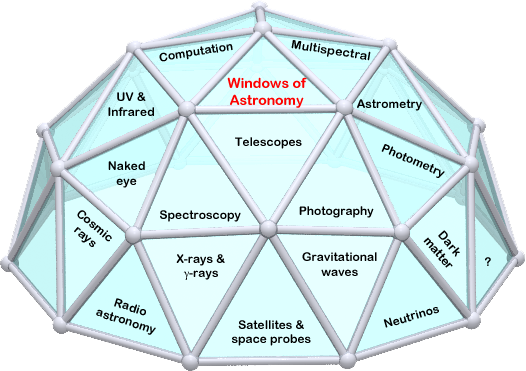Windows of Astronomy |
Introduction
You walk slowly around a picture gallery. Within each frame on the walls is the artist's interpretation of a view, incomplete in detail and incomplete in representing what is beyond the canvas. No special training is needed to see the pictures but the knowledgeable will get more out of the visit. That experience is a good metaphor for this piece. My gallery is the view outwards from the Earth.
|
The stars and planets have surely been discussed since there has been language to do so. The records of astronomy, though, date back only some three millennia. For most of that time, all that our ancestors had were their naked eyes. As we can now say, an object the size of a golf ball with a small hole in it is a woefully inadequate tool for exploring the universe, even when connected to an enquiring mind. Being generous, it’s perhaps not surprising in retrospect that cultures all over the world got the Universe at large wrong. Naked eye vision is one very small window on the Universe. Within the last half millennium mankind has discovered windows unimagined by our ancestors that each give a new view of the universe at large, adding a wealth of knowledge to the overall picture.
|
In the last half century mankind's view of the universe, what's in it, how it evolves and where we are in it, has been transformed - or at least it has been for those who have followed what modern astronomy has revealed. Although a lot of expense has been incurred in getting many people into orbit, sending a few to the Moon and in planning to send others to Mars, not a lot of new knowledge has come from this effort. The new knowledge has largely come from looking through the windows to the universe described here, and exploiting the accompanying technology. I'll cite the mapping of Venus by radar, the determination of the age of the observable universe from the cosmic microwave background, confirmation that there is a huge black hole at the centre of our galaxy from infra-red observations through the galactic dust, the realisation that events of extreme violence take place giving rise to gamma ray bursts, and on an even larger scale gravitational waves. There are many more examples. Putting people in space has generated its own knew knowledge of a different kind.
|
| This piece is my brief look through sixteen windows on the universe. Little background knowledge is assumed. If any of these brief summaries encourages you to look for more detail in authoritative astronomy sources, they will have been worth writing. No references are included but enough use is made of technical words that finding up-to-date information should be quite easy.
|

To select a window, click on it in the dome and a page will open on that topic with text and figure(s)
or
Open a pdf containing all the topics
|
John S. Reid  |

